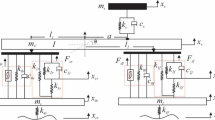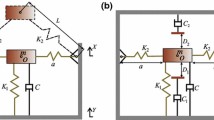Abstract
To reduce the severity of high-magnitude vibrations and shock, end-stop buffers was used for the most suspension cabs or seats of work vehicles. This paper employs a pair of symmetric linear viscoelastic end-stops to improve the performance of a single-degree-of-freedom nonlinear suspension system under primary resonance conditions, which has cubic nonlinearity. Firstly, a piecewise symmetry tri-nonlinear model is introduced. The frequency response of relative displacement corresponding to the steady-state motion is obtained by applying the multiple-scale method, which is found to be the same with the averaging method solution. And it is further verified by numerical simulation. Its stability is then studied. Subsequently, a design criterion is proposed for jump avoidance, which is caused by the saddle-node bifurcation. Also, parametric studies are carried out to illustrate effects of design parameters for the end-stop on the isolation performance at primary resonance, including responses of the relative displacement and the absolute acceleration. The results show that with dynamic parameters properly designed by using viscoelastic end-stops, the relative displacement response can be effectively suppressed and the jump can be eliminated for both hardening and softening primary isolators. Besides, the end-stop can effectively attenuate the absolute acceleration response for a hardening primary isolator, while more damping is needed to attenuate that for a softening primary isolator, although the degree of the softening nonlinearity is mitigated. It is suggested that a moderate stiffness compared to that of the primary isolator and also a high damping of the end-stop be beneficial to both vibration isolation and jump avoidance under primary resonance conditions.













Similar content being viewed by others
References
Wu, X., Griffin, M.J.: The influence of end-stop buffer characteristics on the severity of suspension seat end-stop impacts. J. Sound Vib. 215(4), 989–996 (1998)
Lemerle, P., Boulanger, P., Poirot, R.: A simplified method to design suspended cabs for counterbalance trucks. J. Sound Vib. 253(1), 283–293 (2002)
Rakheja, S., Boileau, P.-É., Wang, Z., et al.: Performance analysis of suspension seats under high magnitude vibration excitations: part I: model development and validation. J. Low Freq. Noise Vib. Act. Control 22(4), 225–252 (2003)
Gunston, T.P., Rebelle, J., Griffin, M.J.: A comparison of two methods of simulating seat suspension dynamic performance. J. Sound Vib. 278(1), 117–134 (2004)
Rebelle, J.: Methodology to improve the performance of the end-stop buffers of suspension seats. Veh. Syst. Dyn. 42(4), 211–233 (2004)
Zhou, C., Sun, B., Chen, N., et al.: Ride comfort simulation and experimental research of nonlinear rubber suspension system. J. Southeast Univ. (Nat. Sci. Ed.) 37(1), 30–34 (2007). (in Chinese with English abstract)
Milburn, R.J., Bakken, M., Virgilio, S., et al.: Cab suspension system for an off-road vehicle. US Patent No. 8,807,633 B2 (2014)
Zhong, S., Chen, Y.: Bifurcation of piecewise-linear nonlinear vibration system of vehicle suspension. Appl. Math. Mech. (Engl. Ed.) 30(6), 677–684 (2009)
Le, V.Q., Zhang, J., Liu, X., et al.: Nonlinear dynamic analysis of interaction between vehicle and road surfaces for 5-axle heavy truck. J. Southeast Univ. (Engl. Ed.) 27(4), 405–409 (2011)
Ward, C.H.: The application of a new cab mounting to address cab shake on the 2003 Chevrolet Kodiak and GMC Topkick. In: SAE Technical Paper Series 2002-01-3102
Sun, X., Zhang, J.: Performance of earth-moving machinery cab with hydraulic mounts in low frequency. J. Vib. Control 20(5), 724–735 (2014)
Tuncel, O., Sendur, P., Özkan, M., et al.: Technical note: ride comfort optimization of Ford cargo truck cabin. Int. J. Veh. Des. 52(1), 222–236 (2010)
Naraynan, S., Sekar, P.: Periodic and chaotic responses of an SDF system with piecewise linear stiffness subjected to combined harmonic and flow induced excitations. J. Sound Vib. 184(2), 281–298 (1995)
Ing, J., Pavlovskaia, E., Wiercigroch, M.: Dynamics of a nearly symmetrical piecewise linear oscillator close to grazing incidence: modelling and experimental verification. Nonlinear Dyn. 46, 225–238 (2006)
Ing, J., Pavlovskaia, E., Wiercigroch, M., Banerjee, S.: Experimental study of impact oscillator with one-sided elastic constraint. Philos. Trans. R. Soc. A 366, 679–704 (2008)
Liu, Y., Pavlovskaia, E., Wiercigroch, M.: Experimental verification of the vibro-impact capsule model. Nonlinear Dyn. 83, 1029–1041 (2016)
Wiercigroch, M., Sin, V.W.T.: Experimental study of a symmetrical piecewise base-excited oscillator. ASME J. Appl. Mech. 65, 657–663 (1998)
Narimani, A., Golnaraghi, M.F., Jazar, R.N.: Optimizing piecewise linear isolator for steady state vibration. In: Proceedings of IMECE’03 2003 ASME International Mechanical Engineering Congress, Washington, D.C., Nov. 15–21 (2003)
Narimani, A., Golnaraghi, M.F., Jazar, G.N.: Frequency response of a piecewise linear vibration isolator. J. Vib. Control 10, 1775–1794 (2004)
Deshpande, S., Mehta, S., Jazar, G.N.: Optimization of secondary suspension of piecewise linear vibration isolation systems. Int. J. Mech. Sci. 48(4), 341–377 (2006)
Jazar, G.N., Mahinfalah, M., Deshpande, S.: Design of a piecewise linear vibration isolator for jump avoidance. Proc. Inst. Mech. Eng. Part K 221(3), 441–450 (2007)
Wallentowitz, H.: Automotive Engineering II: Vertical and Lateral Dynamics of Vehicles. China Machine Press, Beijing (2009)
Mallik, A.K., Kher, V., Puri, M., Hatwal, H.: On the modeling of non-linear elastomeric vibration isolators. J. Sound Vib. 219(2), 239–253 (1999)
Shaska, K., Ibrahim, R.A., Gibson, R.F.: Influence of excitation amplitude on the characteristics of nonlinear butyl rubber isolators. Nonlinear Dyn. 47, 83–104 (2007)
Natsiavas, S., Tratskas, P.: On vibration isolation of mechanical systems with non-linear foundations. J. Sound Vib. 194(2), 173–185 (1996)
Stahl, P., Jazar, G.N.: Frequency response analysis of piecewise nonlinear vibration isolator. In: Proceedings of IDETC/CIE 2005, ASME International Design Engineering Technical Conferences and Computers and Information in Engineering Conference, Long Beach, CA, USA, Sept. 24–28 (2005)
Stahl, P., Jazar, G.N.: Stability analysis of a piecewise nonlinear vibration isolator. In: Proceedings of IMECE2005, ASME International Mechanical Engineering Congress and Exposition, Orlando, FL, USA, Nov. 5–11 (2005)
Hao, Z., Cao, Q., Wiercigroch, M.: Two-sided damping constraint control strategy for high-performance vibration isolation and end-stop impact protection. Nonlinear Dyn. 86(4), 1–16 (2016)
Andreaus, U., De Angelis, M.: Nonlinear dynamic response of a base-excited SDOF oscillator with double-side unilateral constraints. Nonlinear Dyn. 84(3), 1447–1467 (2016)
Yan, Y., Liu, Y., Liao, M.: A comparative study of the vibro-impact capsule systems with one-sided and two-sided constraints. Nonlinear Dyn. 89, 1063–1087 (2017)
Liu, Y., Páez, Chávez J.: Controlling multistability in a vibro-impact capsule system. Nonlinear Dyn. 88, 1289–1304 (2017)
Gao, X., Chen, Q.: Nonlinear frequency response analysis and dynamics design of a solid and liquid mixture nonlinear vibration isolator. J. Vib. Control 20(15), 2389–2400 (2013)
Gao, X., Chen, Q.: Nonlinear analysis, design and vibration isolation for a bilinear system with time-delayed cubic velocity feedback. J. Sound Vib. 333(6), 1562–1576 (2014)
Cheng, C., Li, S., Wang, Y., et al.: On the analysis of a high-static-low-dynamic stiffness vibration isolator with time-delayed cubic displacement feedback. J. Sound Vib. 378, 76–91 (2016)
Sun, B., Zhou, C., Zhang, X., et al.: Nonlinear dynamic characteristics of rubber suspension of construction vehicle. J. Southeast Univ. (Nat. Sci. Ed.) 37(6), 974–979 (2007). (in Chinese with English abstract)
Nayfeh, A.H., Mook, D.T.: Nonlinear Oscillations. Wiley-VCH Verlag GmbH & Co. KGaA, Weinheim (2004)
Kandil, A., Eissa, M.: Improvement of positive position feedback controller for suppressing compressor blade oscillations. Nonlinear Dyn. 90(3), 1727–1753 (2017)
Li, L., Zhang, Q., Wang, W., et al.: Nonlinear coupled vibration of electrostatically actuated clamped-clamped microbeams under higher-order modes excitation. Nonlinear Dyn. 90(3), 1593–1606 (2017)
Liu, F., Xiang, C., Liu, H., et al.: Nonlinear vibration of permanent magnet synchronous motors in electric vehicles influenced by static angle eccentricity. Nonlinear Dyn. 90(3), 1851–1872 (2017)
Babitsky, V.I., Veprik, A.M.: Universal bumpered vibration isolator for severe environment. J. Sound Vib. 218(2), 269–292 (1998)
Zhang, R., Li, K., Yu, F., et al.: Novel electronic braking system design for EVS based on constrained nonlinear hierarchical control. Int. J. Automot. Technol. 18(4), 707–718 (2017)
Zhang, R.H., Ma, Y.B., You, F., Peng, T., He, Z.C., Li, K.N.: Exploring to direct the reaction pathway for hydrogenation of levulinic acid into gvalerolactone for future clean-energy vehicles over a magnetic Cu–Ni catalyst. Int. J. Hydrog. Energy 42(40), 25185–25194 (2017)
Brennan, M.J., Kovacic, I., Carrella, A., Waters, T.P.: On the jump-up and jump-down frequencies of the duffing oscillator. J. Sound Vib. 318, 1250–1261 (2008)
Zhang, R.H., He, Z.C., Wang, H.W., You, F., Li, K.N.: Study on self-tuning tyre friction control for developing main-servo loop integrated chassis control system. IEEE Access 5, 6649–6660 (2017)
You, F., Zhang, R., Guo, L., et al.: Trajectory planning and tracking control for autonomous lane change maneuver based on the cooperative vehicle infrastructure system. Exp. Syst. Appl. 42(14), 5932–5946 (2015)
Song, H., Zheng, P., Ge, H.: TDGL and mKdV equations for an extended car-following model. Nonlinear Dyn. 90(4), 2253–2262 (2017)
Zhang, R., Li, K., He, Z., et al.: Advanced emergency braking control based on a nonlinear model predictive algorithm for intelligent vehicles. Appl. Sci. 7(5), 504 (2017)
Acknowledgements
This work was supported by the Dr. Scientific Research Foundation of Taiyuan University of Science and Technology (Grant No. 20142035), the Natural Science Foundation Project of Shanxi Province China (Grant No. 201701D121069) and the National Natural Science Foundation of China (Grant Nos. 51775565, 51208500).
Author information
Authors and Affiliations
Corresponding author
Ethics declarations
Conflict of interests
The authors declare that there is no conflict of interests regarding the publication of this article.
Appendices
Appendix A
Using the averaging method
Then, the following equation is implied
And the acceleration is
Considering \(\varphi =\lambda \tau +{\bar{\gamma }}\) and defining \(\varphi _0 =\left\{ {\begin{array}{ll} \arccos \frac{d}{\bar{{A}}}\in \left( {0,\frac{\pi }{2}} \right) &{} \bar{{A}}>d \\ 0 &{} \bar{{A}}\le d \\ \end{array}} \right. \), substitute (A1), (A2) and (A4) into Eq. (2)
where
Because only \(\varphi _0 \le \varphi \le \pi -\varphi _0\) or \(\pi +\varphi _0 \le \varphi \le 2\pi -\varphi _0\) can be true when \(\varphi _0 =0\), \(G_{1}\) is true under both conditions of \(A>d\) and \(A\le d\).
Solving Eqs. (A3) and (A5) for \(\dot{\bar{{A}}}\) and \(\dot{{\bar{\gamma }}}\), we have
Averaging them over the period \(2\pi /\lambda \), we have
At the steady-state condition, the derivatives \({\dot{A}}\) and \(\dot{{\bar{\gamma }}}\) can be considered to be zero. Then,
Therefore,
Appendix B
Rights and permissions
About this article
Cite this article
Sun, X., Zhang, H., Meng, W. et al. Primary resonance analysis and vibration suppression for the harmonically excited nonlinear suspension system using a pair of symmetric viscoelastic buffers. Nonlinear Dyn 94, 1243–1265 (2018). https://doi.org/10.1007/s11071-018-4421-9
Received:
Accepted:
Published:
Issue Date:
DOI: https://doi.org/10.1007/s11071-018-4421-9




